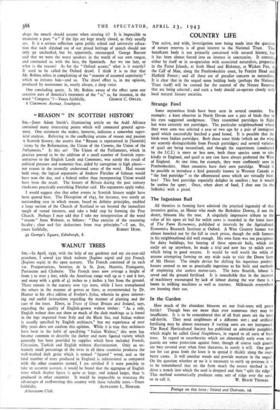WALNUT TREES
Sta,—In April, 1939, with the help of my gardener and my six-year-old grandson, I sowed 35o black walnuts (7uglans nigra) and 35o French (juglans regia) in the open nursery. The French consisted of so each var. Praeparturiens, Serotine, de la St. Jean, Mayette, Franquette, Parisienne and Chaberte. The French trees now average a height of from 3 to over 5 feet, while the American range well up to 7 and 8 feet, and many with a girth of 41 inches to 5 inches 2 feet from the ground. There remain in the nursery now 15o trees, while I have transplanted the others in the manner of groves or lines, as recommended by Dr. Hunter in his 1812 edition of Evelyn's Sylva, wherein he gives interest- ing and useful instructions regarding the manner of planting and the care of the trees. Elwes, in Trees of Great Britain and Ireland, says, regarding the quality of English-grown walnut timber: " As a rule, English walnut does not show so much of the dark markings as is found in the logs imported from Italy and the Black Sea, and Italian walnut is usually specified by English architects," but my experience of over fifty years does not confirm this opinion. While it is true that architects have been in the habit of specifying " Italian Walnut," this term has become common to describe the darker and more figured variety which generally has been provided by supplies which have included French, Circassian, Turkish and English without discrimination. Only an ex- tremely small percentage of the trees in all these countries produces the well-marked dark grain which is termed " figured " wood, and as the total number of trees produced in England is infinitesimal as compared with the other countries named, I am satisfied if it were possible to take an accurate account, it would be found that the aggregate of English trees which display figure is quite as large, and indeed larger, than is produced in other countries It would be impossible to overstate the advantages of reafforesting this country with these valuable trees.—Yours


























 Previous page
Previous page